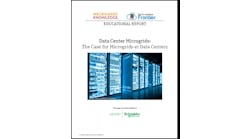More utility microgrids — beyond universities and military bases — are among the 2016 predictions by S&C Electric’s Wanda Reder.
EPB of Chattanooga, Tennessee, has an interesting story to tell. It has many, in fact. In July 2012, citing just one example, the Chattanooga region experienced one of its largest-ever storms, causing power outages to about 80,000 homes and businesses. EPB automatically restored power to 53 percent of those affected through the use of recently deployed distribution-automation technology.
This improvement reduced the total restoration time by about 17 hours, and it is providing millions of dollars of benefit per year.
Aided by stimulus money under the Department of Energy’s American Reinvestment and Recovery Act of 2009, EPB and other utilities have spent about $9 billion over the past five years to apply technology and improve their grid performance. With the five-year run ending in 2015, my expectation is that in 2016 many more utilities will have strong stories to tell touting similar achievements. Why? Because they now have real things to talk about and data to back them up, not just projections.
Other predictions I have for 2016 similarly reflect the changing environment in which utilities operate. Here are some, in no particular order, that I view as being among the most important:
• The emphasis on power reliability will continue. As a society, we’re becoming more and more dependent on the grid. Where we see wide-sweeping outages, there is concern because the outages are costly. Hurricane Sandy certainly brought that to our attention. We also are seeing more companies focus on pockets of customers who have experienced outages multiple times. Companies such as Florida Power & Light are making a significant investment in grid performance, pointing to an emerging trend where I believe more utilities will make larger-scale reliability investments to improve grid performance to meet the emerging expectations of their customers.
• More communities and municipalities will work together to find and combine synergies across their multiple infrastructures. They will do so to deliver better services to their customers. The electrical infrastructure is the glue that brings infrastructures together; communities and municipalities are going to become much more collaborative and proactive about planning for infrastructure interdependencies and economic synergies to improve local conditions. They’re taking the situation into their own hands, putting in battery storage and renewables on their own premises to shore up the risk of significant catastrophic events and security breaches.
• Microgrids will expand beyond universities and military bases. Driven in large part by what I described above, utilities will be venturing into this space increasingly more often. Without load growth to spur traditional investment, microgrid development provides an opportunity for utilities to actively engage in interconnecting with the grid, be a part of deploying distributed energy resources, and improve reliability to meet emerging customers’ needs. Movement in this direction will require regulatory changes. If these changes are approved, utilities will likely invest in this arena and improve reliability and security for those who need it most.
• Regulatory-reform efforts will rise. Rooftop photovoltaic (PV) deployments are on the rise, and while they may help customers reduce energy costs, the trend also is putting pressure on utilities, whose financial model has been predicated on capital investment for load growth. With plateauing load, public utility commissions will need to work with utilities to define business models that promote distributed energy resources and ongoing investment for reliable distribution systems that meet present and future needs. The Clean Air Act is a driver for getting more of the U.S. energy supply to come from renewables to meet emission targets in the future. As PV penetration increases, distribution systems will likely need to transform to accommodate multidirectional power flow. Distribution systems have been designed and operated for one-way power flow. Multidirectional power flow will have a significant impact on distribution planning, design, protection, and operations—fundamentally transforming the grid of the future. This is sure to be an area of interest in 2016 and beyond.
• Energy storage will continue to prove its necessary ties to renewable-energy projects. The Brattle Group recently conducted a study for Texas utility Oncor that found 5,000 MWs of storage would make economic sense throughout the Electric Reliability Council of Texas’ (ERCOT) region at $350 per kWh if a merchant market was available and storage could be installed for distribution system benefits. We’re getting closer to reaching that price point, which will help drive growth in storage. However, to unleash the full value of energy storage, market development is needed to allow regulated utilities and the competitive market to both realize benefits from the same asset. If regulated utilities can install storage throughout the grid, it can be used to improve reliability, integrate renewables, and manage peak conditions. We will certainly see this regulatory landscape evolve in 2016.
• Vulnerabilities in our power systems will continue to surface. National Oceanic and Atmospheric Administration data suggest the number of storms cutting power from 50,000 or more customers is rising in the U.S. This points to the fact that we have system vulnerabilities, and climatic conditions are playing a role. Widespread outages are costing society billions. The result will be more emphasis on grid resiliency, especially on the coastal shores where we have recently seen significant damage from hurricanes and other major storms.
• Distributed intelligence will be a must-have grid technology characteristic. Distributed energy resources and the trend for consumers to become “prosumers” is making grid operations more dynamic and uncertain. These conditions will ultimately require distributed intelligence to keep the lights on for customers. We will still need centralized oversite and awareness of what’s going on, but getting the intelligence distributed in the field so there’s increased awareness and timely action based on local conditions is an inevitable trend because of how dynamic things are becoming.






